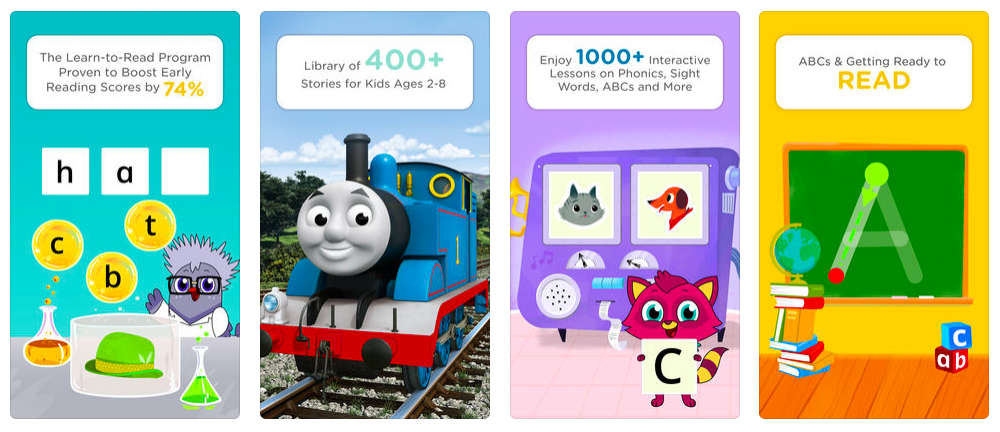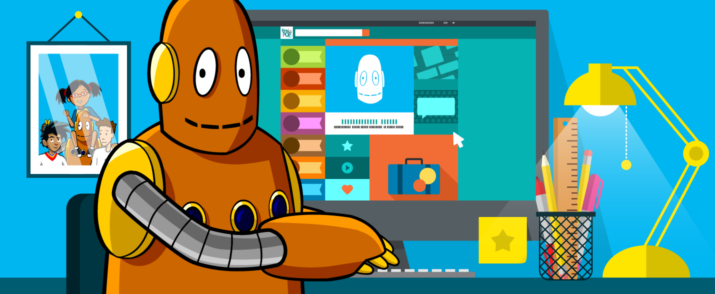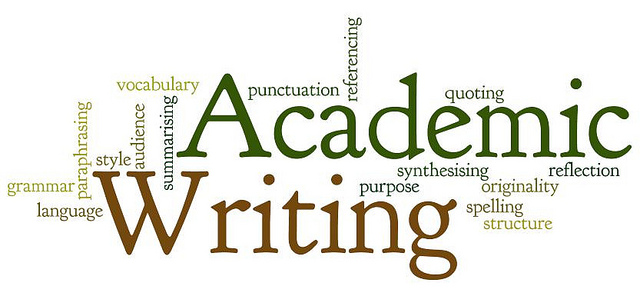Students nowadays can barely fathom a world without digital flashcards, video tutorials, online learning games, and the powers of Google to handle just about any task. The wealth of online resources and apps to support student learning and organizational skills is seemingly endless, which is why it is so important to narrow down the field to identify the best tools to effectively support our students. With that in mind, this month’s blog posts highlight our favorite tech resources for elementary, middle, and high school students. From math and reading games, to instructional videos and 21st century literary guides, we’ve featured sites and apps to help learners of all ages.
Best Apps and Sites for Elementary Students
QuickMath
QuickMath is a great tool for students in Grades 1-6 to build fluency with their addition, subtraction, multiplication, and division math facts. With three different levels for each operation, and the ability to track progress after each round of play, this app is an excellent alternative to standard flash cards. Plus, students love that they can write their answer directly on the screen! There are also more wonderful apps in the QuickMath family, including QuickMath Jr. for students in K - 2, and QuickMath Fractions for students in Grades 3-6.
Math Playground
Math Playground is an incredible site with a wealth of math games, logic puzzles and a variety of
problem solving activities. It is a great resource for arcade style math games, digital manipulatives for illustrating mathematical concepts and operations, and even coding practice. With over 500 different activities to choose from, it will be hard for any child to complain about being “bored” with the games.
Epic!
Epic! is a digital library for children offering over 25,000 high-quality ebooks, audiobooks, learning videos, and quizzes for kids 12 and under. This app’s award-winning service includes a wide variety of high-quality books and learning videos from leading publishers like Scholastic, National Geographic, HarperCollins, Macmillan, Smithsonian and many more. The Epic! library contains everything from picture books to chapter books, early readers, audiobooks, graphic novels, non-fiction titles, educational books, videos and more, and it even offers books in Spanish and Chinese.
Homer
Homer is an incredible literacy app for children age 2-8. With thousands of lessons and activities that target the development of phonics skills, sight word knowledge, the ABCs and more, this app is a great way to build confidence with the earliest of reading skills. In addition, the app also includes tons of digital books and interactive stories to promote independent reading from a young age. Homer Reading has been proven to increase early reading scores by 74% with just 15 minutes a day. And with stories and activities customized to each child’s interests, they’ll learn while having fun.
BrainPop Jr.
BrainPop Jr. will help kids as young as 5 learn something about any topic they can dream of in a developmentally appropriate way. Ideal for kids in Kindergarten through grade 3, BrainPOP Jr. spans topics across Science, Social Studies, Reading, Writing, Math, Health, Arts, and Technology. The gentle, humorous, and relatable characters Annie and Moby serve as guides through each topic, empowering kids to form their own ideas. BrainPOP Jr. is designed to cultivate critical thinking skills and encourage children to ask questions and make connections.
Digital Tools for Middle School (and beyond)
Flashcards of the Future
Quizlet is an online and app-based interactive flashcard system that is invaluable for digitally minded students who can progress with relatively little friction through flashcards sets they create in advance of tests or quizzes. Creating a basic account is free, and offers access to the platform’s quiz games and “learn” feature, which tracks performance and selects the cards that continue to give students trouble, effectively tailoring the test to what the student knows and doesn’t know. A recent update makes Quizlet especially easy to use with vocabulary lists — when you enter a word into the list, Quizlet will automatically generate definitions for you to choose between from its built-in dictionary. Another under-explored feature of Quizlet is the library of crowd-sourced lists — while usually students will want to make their own lists based on their specific material, study lists already exists for many common courses (such as AP US History, or Spanish II). These can be used as a way to check student work and preview or review a difficult textbook reading.
Student News
Newsela is a news aggregator focused on providing articles for students - this means that its staff gathers articles from news sources across the web, and then adjusts them to its audiences in schools. The articles are organized by topic area, and often published ‘adaptively,’ so that students can select their reading level and the article’s text will subtly change (in its vocabulary and syntax) according to their individual skill.
The Digital Classroom
Khan Academy is a fantastic resource for short video lessons, generally focused on math, science, and computer science at all grade levels. This is a great place to go for additional practice in a particular subject area — along with videos, there are short tests and practice questions that students can use to test their understanding. There are also diagnostic quizzes that will help place students along the spectrum of skill levels, and a point system that allows students to earn badges for mastering content. The core feature, though, is video content that can be paused, replayed, slowed down, so that students can review a challenging concept from class at their own pace while working through a difficult homework task. And heads up for the high school years — Khan Academy recently partnered with Collegeboard to offer a completely free SAT prep curriculum, including practice tests and problem breakdowns.
Brainpop
Brainpop is another resource for educational videos and games—but with an animated, cartoon look that is approachable and engaging, better for some students than the blackboard aesthetic of Khan Academy (and with a wider range of topics).
High School Helpers
Online Reading Guides
Lit Charts is a competitor of SparkNotes, and offers a well-designed theme-tracking interface that makes it easy to ‘chart’ the development of a major theme from chapter to chapter, which can be very helpful when seeking out evidence for an analytical essay — there’s even a section on important quotes organized by theme. It’s also a source for very thorough summary and analysis breakdowns, chapter by chapter and page by page, so that students can preview difficult texts or review before an exam. Two more helpful features: the literary devices and terms reference guide, and a modern, line by line adaption of every play by William Shakespeare.
Academic Writing Centers
Academic writing centers can provide guidance as students begin to embark on more challenging essay assignments. The Harvard Writing Center site offers tips for each step of the writing process, from breaking down an assignment to developing a thesis, and from rough draft to final copy. The Purdue OWL (Online Writing Lab) is another great resource for academic writing — when we use Purdue OWL with students, though, it’s most often specifically to explore the comprehensive guide to citation practices. Whether your student’s teacher prefers MLA, APA, or Chicago Style citations, Purdue OWL is one of the web’s best references for the nuanced formatting requirements of a well-made bibliography.
Citation Tools
BibMe, or any of its comparable competitors (such as Easybib, Citationmachine, Citefast), is a quick and easy upgrade to the traditional approach to creating a bibliography. Students can enter the title of a book, journal article, or website, specify a style of citation, and then sit back while the site seeks out the relevant publication information and generates a complete citation. As with any time-saving digital shortcut, though, be sure to double check the site’s work, so that the occasional glitch does not slip by undetected.
The Google Toolbox
Google Drive, Google Docs, Google Slides, Google Sheets — Students today will no doubt already have encountered the most common of these Google Apps before high school, but now is the time to master them. It’s worth taking the time to create an organizational system for docs and slides in Google Drive, broken down by school year and subject. Students should also play around with the different collaboration tools, learning how to make suggested edits and respond to comments. With the right adjustment in settings, Google Docs can also be edited and composed offline, which can be incredibly valuable when students are fighting to remain focused in the always-connected cybersphere. One under appreciated app in the Google toolbox is Google Keep, an intuitive checklist maker and digital bulletin board that can be a useful place to track assignments and gather notes - an easily installable extension in Google Chrome will allow students to pin any article from across the web on their Keep platform, and notes can then be tagged to a specific category and color coded for organization. Encourage students to explore how they can customize their experience with these apps to work more efficiently and increase their productivity.
Spellchecker 2.0
Grammarly is an online grammar checking app that can effectively proofread both academic papers and everyday emails; if students submit an essay to the Grammarly platform, they can receive a detailed breakdown of grammatical errors with short explanations or suggested fixes, cleanly and clearly displayed. The app will also automatically detect plagiarism, using a web-scraping capability similar to that now used by many teachers to check over digitally submitted assignments. With this function, students can be alerted to any quotes or ideas in their work that haven’t been properly cited before they turn it in as a finished product.














